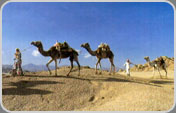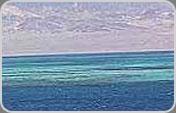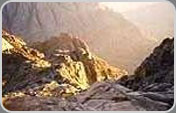|

 This is the South Sinai This is the South Sinai
 The Sinai peninsula has been the gateway between Africa and Asia since time immemorial and a battleground for millennia. Prized for its strategic position and mineral wealth, Sinai is also revered by disparate cultures as the site of God's revelation to Moses, the wanderings of Exodus and the flight of the Holy Family. As Burton Bernstein wrote, it has been touched, in one way or another by most of Western and Near Eastern history, both actual and mythic". The Sinai peninsula has been the gateway between Africa and Asia since time immemorial and a battleground for millennia. Prized for its strategic position and mineral wealth, Sinai is also revered by disparate cultures as the site of God's revelation to Moses, the wanderings of Exodus and the flight of the Holy Family. As Burton Bernstein wrote, it has been touched, in one way or another by most of Western and Near Eastern history, both actual and mythic".
 Though mostly wilderness, Sinai looks far too dramatic - and too beautiful - to be dismissed as "24 000 square miles of nothing". The interior of Southern Sinai is an arid moonscape of jagged ranges harboring Mount Sinai and Saint Catherine's Monastery, where pilgrims climb the Steps of Repentance from the site of the Burning Bush to the summit where God delivered the Ten Commandments. Further north, the vast Wilderness of the Wanderings resembles a Jackson Pollock canvas streaked with color and and imprinted with tank tracks. Remote springs and lush oases can be reached by camel trekking or jeep safaris, providing some insights into Bedouin culture. Above all, however, the south has the lure of exquisite coral reefs and tropical fish in the Gulf of Aqaba, one of the finest diving and snorkeling grounds in the world. The beach resorts at Sharm El Sheikh, Na'ama bay, Dahab and Nuweiba cater to every taste and budget, From Sharm El Sheikh to Na'ama Bay you can also make expeditions to Egypt's deepest reefs and most aquatic life at Ras Mohamed, a mini peninsula at the southern tip of Sinai. Northwest of here, The Gulf of Suez pales by comparison with its eastern counterpart - there are no reefs and only few sites to interest the visitor. Northern Sinai is visited by almost no Western tourists. A barren coastline, which you scarcely glimpse from the road, it has a single town and focus in El Arish, a laid back if conservative place with a palm fringed beach and Bedouin market.. Though mostly wilderness, Sinai looks far too dramatic - and too beautiful - to be dismissed as "24 000 square miles of nothing". The interior of Southern Sinai is an arid moonscape of jagged ranges harboring Mount Sinai and Saint Catherine's Monastery, where pilgrims climb the Steps of Repentance from the site of the Burning Bush to the summit where God delivered the Ten Commandments. Further north, the vast Wilderness of the Wanderings resembles a Jackson Pollock canvas streaked with color and and imprinted with tank tracks. Remote springs and lush oases can be reached by camel trekking or jeep safaris, providing some insights into Bedouin culture. Above all, however, the south has the lure of exquisite coral reefs and tropical fish in the Gulf of Aqaba, one of the finest diving and snorkeling grounds in the world. The beach resorts at Sharm El Sheikh, Na'ama bay, Dahab and Nuweiba cater to every taste and budget, From Sharm El Sheikh to Na'ama Bay you can also make expeditions to Egypt's deepest reefs and most aquatic life at Ras Mohamed, a mini peninsula at the southern tip of Sinai. Northwest of here, The Gulf of Suez pales by comparison with its eastern counterpart - there are no reefs and only few sites to interest the visitor. Northern Sinai is visited by almost no Western tourists. A barren coastline, which you scarcely glimpse from the road, it has a single town and focus in El Arish, a laid back if conservative place with a palm fringed beach and Bedouin market..
 Sinai, the land of arid wilderness and mystic beauty is consisting of rugged mountains between the Gulf of Suez and Aqaba. These mountains form rows of granite walls that change color with each passing hour. These coastlines meet at Ras Mohamed in the Red Sea, where reefs of magnificent coral lie just below the water’s surface. Sinai, the land of arid wilderness and mystic beauty is consisting of rugged mountains between the Gulf of Suez and Aqaba. These mountains form rows of granite walls that change color with each passing hour. These coastlines meet at Ras Mohamed in the Red Sea, where reefs of magnificent coral lie just below the water’s surface.
The Sinai has a very long history and a civilization taking us back to the Pharaonic times. It is where Isis traveled through to search for Osiris. The Pharaohs appointed the goddess Hathor at the head of this sacred part of their land. They extracted from it gold, copper and turquoise which has justified the name of "The country of Turquoise".
Since the days of the Pharaohs, armies have used this strategic peninsula as a bridge between Asia and Africa. Some of the routes through the northern desert, crossed by Egypt’s King Thutmose III to attack Palestine and Syria in the 15th century B.C were recrossed in 1967 by Israeli tanks heading the other way.
Alexander the Great marched through Sinai in 332 B.C to conquer Egypt, as did Amr Ibn El As in 639 to bring Islam to Africa. Turkish Sultan Selim the Grim crossed in 1517 to make Egypt part of Ottoman Empire. Napoleon Bonaparte swept through in 1799 during his brief adventures in the Middle East.
It is also in Sinai that God revealed himself to Moses in the miracle of the Burning Bush and ordered him to return to Egypt, and bring the Children of Israel to Mount Horeb in order to serve him.
|